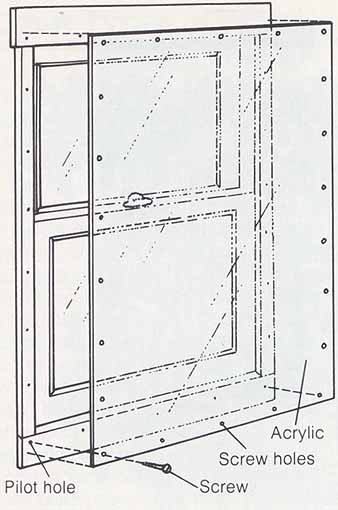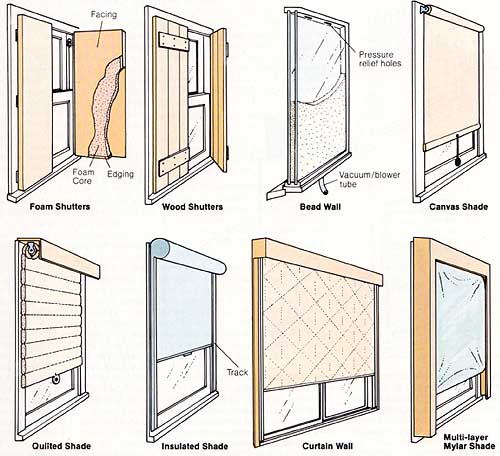You can make a single-pane, solid plastic interior storm window yourself. and although it is somewhat more complex and expensive to construct than plastic sheeting storm, it also is reusable, relatively attractive, and less fragile than either glass or 6-mil polyethylene. The expense of this project is limited to a few screws and some ¼-inch clear acrylic plastic, at $4 to $4.50 per square foot.
1. Measure the length and width of the window you intend to cover, so that all the edges of your storm window will extend 1 inch over a flat surface. The window casing will work well if it is not a curved molding.
2. Draw the storm window you just measured onto masking paper covering a sheet of 14 inch clear acrylic plastic.
If you are adept with a circular saw, cut the acrylic yourself. Otherwise, ask your plastics supplier to cut the acrylic to your exact measurements, or to have it cut for you. Do not practice on this sheet.
3. Sand the edges of the acrylic with fine sandpaper. Starting with the four corners, drill holes evenly spaced, no more than 12 inches apart, ½-inch in from the edge of the acrylic.
4. Hold the acrylic over the window it is to cover, and mark the screw-holes on the window casing or other flat surface surrounding the window.
5. Using a smaller bit than was used to drill the acrylic, drill starter holes in the casing where you have made marks.
6. Hold the acrylic up to the holes and screw it to the casing with brass-finish or roundhead screws.
7. If the acrylic doesn’t fit tightly, insert felt, reinforced felt, or plastic foam weatherstripping.
You can remove this storm window any time simply by taking out the screws.
If you store the storm window, cover it with soft cloth so the acrylic doesn’t get scratched.

How to Install an Acrylic Plastic Storm Window

Other Interior Window Insulation: Quilted Shade, Insulated
Shade, Multi-layer Mylar Shade
Types of Interior Window Insulation:
Insulation |
Cost (materials only) |
Effectiveness |
Remarks |
Foam boards (1” thick) (insulating shutter) |
About $1 per square foot |
Very good. Improve single-pane insulation about five times. |
Sometimes difficult to achieve tight fit; not particularly attractive without additional covering. May want to frame with wood, then hinge, and fit to window. Most foam boards are made of flammable materials, so face with aluminum or some other fireproof material. |
Wooden shutters |
$2-3 per square foot |
Acceptable. Double insulating efficiency of single-pane window. |
Solid shutters are more effective than louvered ones. Sometimes difficult to achieve tight fit. |
Reflective film |
50c-$1 per square foot |
Acceptable. May double insulating efficiency of single-pane window, |
Easy to apply in small areas (up to about 2’ x 3’), but reduces incoming light and may blister, peel, and look unsightly. |
Canvas roll-down window shades |
$2-6 for 3’ x 6’ shade |
Better than nothing. Cut heat loss through the window by about 25%. |
Easy to put up, easy to use, and if you don’t like their looks you can paint or cover them. Of minimal insulation value—they don’t make a tight seal anywhere, and wind and cold can penetrate them. |
Acrylic plastic storm window |
$2-2.50 per square foot for 1/4” thickness |
Acceptable. Doubles insulating efficiency of single-pane window. |
Available in kits at some home improvement centers, or can be made at home (see instructions, above). |
Quilted shade |
About $4 per square foot for five layers of insulation |
Good. Improves insulating efficiency of single-pane window about four times. |
An insulation sandwich with reflective Mylar at the center, surrounded by two 1/4” thick layers of polyester batting, surrounded in turn by two layers of polyester-rayon. Tracks at the sides and weights at the bottom ensure a tight seal. |
Insulating shade |
About $6-7.50 per square foot |
Good. Improves insulating efficiency of single-pane window about four times. |
Three shades—clear inside, tinted in the middle, aluminized reflector on the outside—guided on tracks to ensure tight seal, and designed to make use of solar heat in a passive fashion as well as to insulate. |
Curtain wall |
About $4-7 per square foot |
Excellent. Improves insulating efficiency of single-pane window about ten times. |
Four layers of metal fabric curtain designed to be guided by tracks (not included) for tight side seals. When not in use, the curtain wall stores on a roller and is lowered and raised by an electric motor or by hand. Intended to cover large window areas only. |
Multilayer Mylar shade |
About $4 per square foot. Frame about $1 .50 per linear foot; storage unit about $3 per linear foot |
Remarkable, Improves insulating efficiency of single- pane window about 15 times. |
Five layers of aluminized mylar expand to 3 1/2” of baffled air spaces when drawn. Frame with tracking must be bought or built separately to create tight seal. Maximum width 64”, maximum length 8’. |
Next: Insulating the House